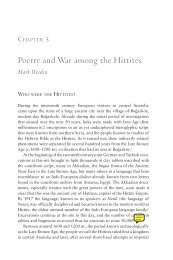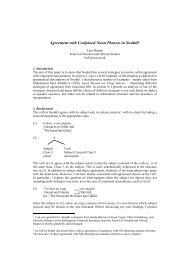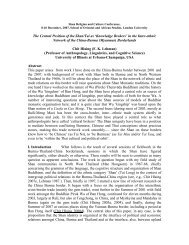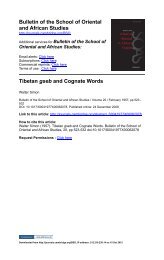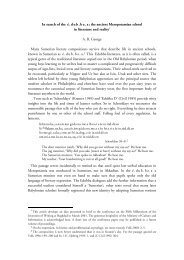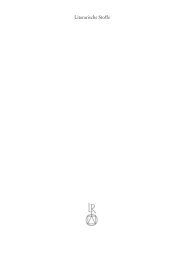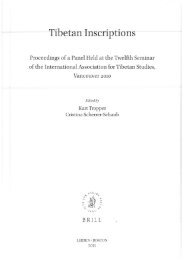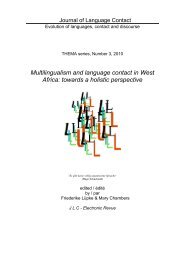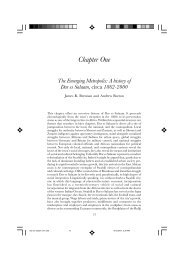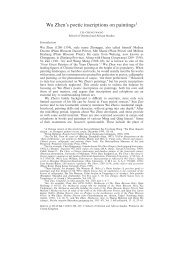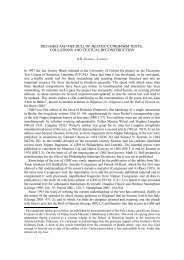Download (316Kb) - SOAS Research Online - The School of ...
Download (316Kb) - SOAS Research Online - The School of ...
Download (316Kb) - SOAS Research Online - The School of ...
Create successful ePaper yourself
Turn your PDF publications into a flip-book with our unique Google optimized e-Paper software.
indo-iranian gar ‘to raise al<strong>of</strong>t’ 253<br />
have based his interpretation on the Dhātupāt.ha gloss and, moreover, may also<br />
have misunderstood it in so far as the true sense <strong>of</strong> the gloss udyamane is ‘to raise<br />
one’s voice’. That is the meaning <strong>of</strong> the verb ud-yam in two Rigvedic passages<br />
where it occurs with the object vácas- ‘word, speech’. Against this view, however,<br />
is the context <strong>of</strong> RV 5.32.6-7, where not only does apa-gur occur but so also does<br />
ud-yam with the clear meaning ‘to raise a weapon’ (vádhar-):<br />
RV 5.32.6<br />
tám. cin mandānó vrs.abháh.<br />
sutásyoccair índro apag ´ūryā jaghāna //<br />
Indra, the bull, intoxicated<br />
˚<br />
by the pressed (Soma), having raised (his arm) al<strong>of</strong>t, 23<br />
slew precisely this one.<br />
RV 5.32.7<br />
úd yád índro mahaté dānav ´āya vádhar yámis.t.a sáho ápratītam /<br />
yád im. vájrasya prábhrtau<br />
dad ´ābha ví´svasya jantór adhamám. cakāra //<br />
When Indra raised his murderous-weapon,<br />
˚<br />
his unopposed force, against the mighty<br />
Dānu-son, when he outwitted him in brandishing the cudgel, he made him the<br />
lowest <strong>of</strong> all creatures.<br />
Stanza 7 clarifies stanza 6 in so far as úd ... vádhar yámis.t.a explains apag ´ūryā,<br />
i. e. in the way that Sāyan. a understood it. Moreover, the passage mentions a trick<br />
used by Indra against his enemy (yád im. vájrasya prábhrtau<br />
dad ´ābha ‘when he<br />
outwitted him in brandishing the cudgel’). Narten convincingly<br />
˚<br />
interprets this<br />
verse as alluding to a special technique employed by Indra when fighting against<br />
Vrtra. ˚ 24 His ploy is referred to as māyā- in other, less explicit passages, such as<br />
RV 1.80.7 and RV 1.32.4:<br />
RV 1.32.4<br />
yád indr ´āhan prathamaj ´ām áhīnām ´ān māyínām ámināh. prótá māy ´āh. /<br />
When you, O Indra, slew the first-born <strong>of</strong> the dragons, then you outwitted even<br />
the deceptions <strong>of</strong> the deceitful ones.<br />
<strong>The</strong> same device further used by Indra against his enemy is also referred to in<br />
the context <strong>of</strong> the second attestation <strong>of</strong> apa-gur in RV 5.29.4:<br />
RV 5.29.4<br />
´ād ródasī vitarám. vís.kabhāyat sam. vivyāná´s cid bhiyáse mrgám.<br />
kah. /<br />
jígartim índro apajárgurān. ah. práti ´svasántam áva dānavám.<br />
˚<br />
han //<br />
<strong>The</strong>n he stemmed heaven and earth apart. Having cloaked himself he frightened<br />
the wild animal. Indra, raising (his arm), slew the voracious, hissing Dānu-son.<br />
23 Schaefer, Intensivum 116 interprets uccaih. as ‘loud’ which would characterize a verbum<br />
dicendi. However, in the Sa ˙mhitās (here and in the Atharva Veda) the form has the local<br />
meaning ‘high’, the metaphorical use ‘loud’ being attested only from Vedic Prose onwards.<br />
24 Narten 1988-90, 148 n. 14 (= Kl.Schr. 386). On the practice <strong>of</strong> deception or trickery<br />
as applied in combat, see Insler 1969, 23-24, where the relevant expression in RV 5.32.7<br />
is translated as ‘when he tricked him into the impact <strong>of</strong> the cudgel’. On pra-bhar as a<br />
technical term for threatening with a weapon, see above p. 3 n. 6.



